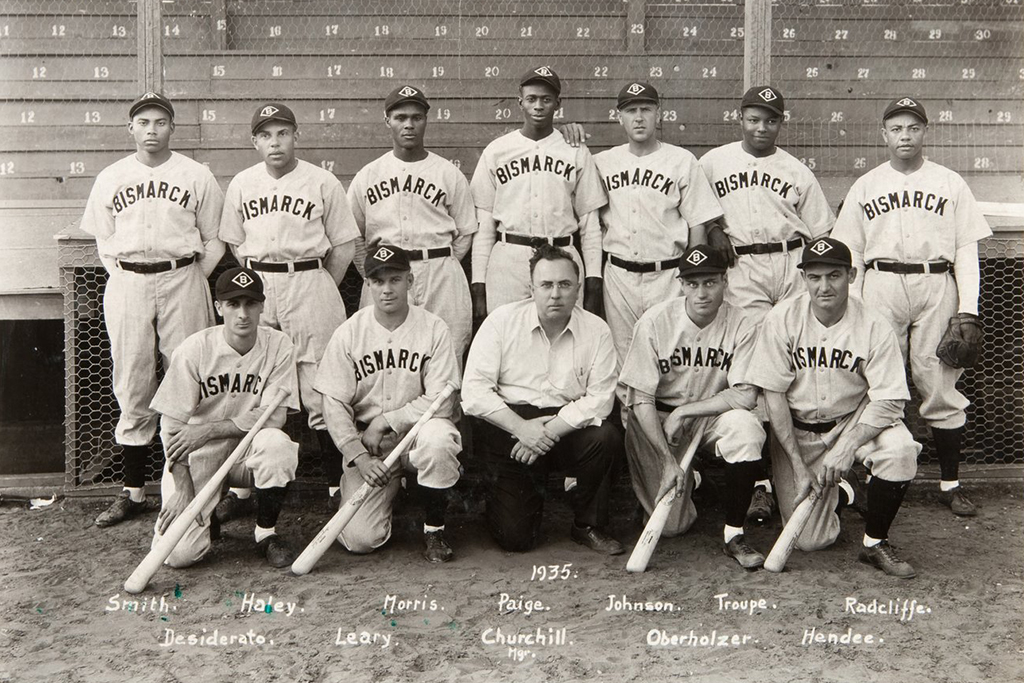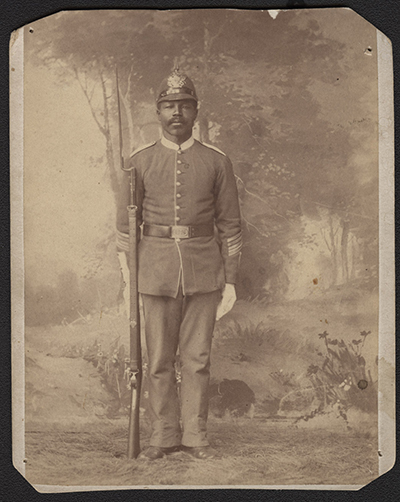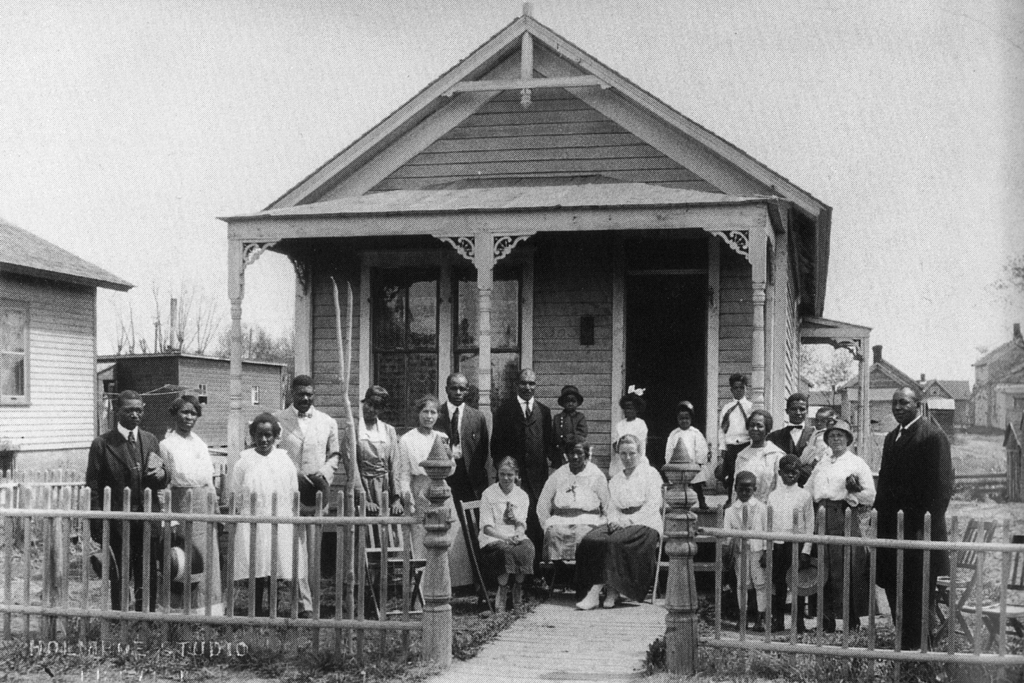Explorers, fur traders, cowboys, soldiers and more
African Americans have been ‘involved in every stage of North Dakota’s history’ from 1800 on, a UND thesis shows

Editor’s note: In 1801, at the newly established Fort Pembina (near the site of present-day Pembina, N.D.), Mrs. Pierre Bonga gave birth to a daughter. And given that Fort Pembina was the first permanent non-Indian settlement in North Dakota, the infant Bonga would be the first child of other than fully Indian ancestry born in North Dakota.
Here’s what Alexander Henry, the Canadian fur trader and explorer who established Fort Pembina, wrote in his diary about the birth:
“Pierre’s wife was delivered of a daughter — the first fruit at this fort, and a very black one.”
Thus begins the history of African Americans in North Dakota, as recounted in a remarkable document that can be found online in the Chester Fritz Library’s Scholarly Commons at UND.
The document is titled “African Americans in North Dakota, 1800-1940.” It’s the thesis that Stephanie Abbott Roper, a graduate student, submitted to fulfill the requirements of her UND master’s degree in 1993.
And to this day, it remains one of the most complete accounts of the Black experience in North Dakota.
This coming Sunday is Juneteenth, the national commemoration of the ending of slavery in the United States. With that in mind, UND Today presents here excerpts from “African Americans in North Dakota, 1800-1940,” the University of North Dakota document that’s unique in its rich treatment of Black history in the state.
In the excerpts that follow, we’ll do our best to describe the most interesting findings of the thesis, as well as its major historical figures — some of whom, we think you’ll agree, deserve entire theses or even Hollywood movies of their own.
But we especially want to alert readers that the full text is available online as a free download at the UND Scholarly Commons. So if these excerpts interest you, feel free to visit the Chester Fritz Library’s Scholarly Commons to access the entire document and learn more.
By the way: Pierre Bonga, the father of the infant daughter mentioned above, is one of the African Americans in North Dakota’s past who likely deserves a biography of his own. A freed Canadian slave, Pierre Bonga “was a Black trapper and interpreter for the North West Company, based in Canada near Mackinac Island,” Wikipedia recounts. “He later worked for John Jacob Astor’s American Fur Company, primarily along the Red River of the North and near Lake Superior in present-day Wisconsin and Minnesota.”
Bonga married an Ojibwe woman named Ojibwayquay, making their children of Black and Indian descent. Several of their youngsters made names for themselves in pioneer Minnesota and Wisconsin; Bungo (sic) Township in Cass County, Minn., is named in one son’s honor.
“Sinclair Lewis, in his novel ‘Kingsblood Royal’ (1947), presents his protagonist Neil Kingsblood as descended from Xavier Pic, a freed slave … who had a life on the American frontier,” Wikipedia recounts.
“As described by Lewis, Pic’s life in the novel loosely parallels that of the historic Pierre Bonga. In addition, Lewis directly refers to the Bonga family in the novel.”

*****
(Excerpts from “African Americans in North Dakota, 1800-1940” follow)
African Americans have been part of the North Dakota story since Alexander Henry traveled through the region in 1800. They served as an integral part of the fabric that forged the state out of the prairies. Thousands of Black men and women have settled and toiled in the state in the last 200 years. They lived and worked alongside immigrants and other newcomers, contributing to the ethnic mixture that made up North Dakota.
Many African Americans, along with thousands of people from other ethnic groups, migrated to the state and then departed, leaving few traces of their existence, while others left an indelible mark on the land and on the people who knew them.
Unfortunately, the presence, as well as the many accomplishments of African Americans in North Dakota, largely have been overlooked. Historians of North Dakota generally have neglected Black people as a group. For example, Elwyn B. Robinson’s ‘History of North Dakota,’ the definitive history of the state, only mentions one African American. … Robert and Wynona Wilkins’ “North Dakota: A History” and Melvin Kazeck’s “North Dakota: A Human and Economic Geography” fail to mention the existence of any Black people whatsoever.
None of these authors state, for example, that the first non-Native American child born in North Dakota was African American. Only the earliest histories, such as Clement Lounsberry’s ‘Early History of North Dakota,’ written in 1919, and Lewis Crawford’s ‘History of North Dakota,’ published in 1931, include this fact.
*****
The goal of this study is to demonstrate the extent to which African Americans were involved in every stage of North Dakota’s history from 1800 to 1940. Black men and women participated in many of the employment categories available to them and forged a niche in the social structure of North Dakota.
Further, the author will explore the motivations for African Americans entering and settling in the state and the reasons why only slightly over 200 Black residents remained in 1940.
*****
After (Pierre) Bonga, the next Black man to enter present-day North Dakota accompanied Lewis and Clark’s Corps of Discovery in 1804. William Clark brought his slave, York, on the voyage to the Pacific Coast. The Native Americans along the Missouri River viewed York as quite a spectacle and traveled for miles to witness him.
Clark related that the Mandans “Came to view us today, much astonished at my Black Servent, who did not lose the opportunity of his powers, Strength &c. &c. this nation never Saw a Black man before.”

*****
(James) Beckwourth was most likely the son of a Virginia planter or overseer and a slave woman. Beckwourth worked for various fur trading expeditions during the 1820s and 1830s in the region that included North Dakota, most notably as an interpreter and agent with the American Fur Company under William Ashley and Kenneth McKenzie. He also claimed to have been named a chief of the Crow.
Beckwourth often traveled to Fort Union and throughout the territory that later became North Dakota.
Edward Rose, the son of a white trader and a half-Black, half-Cherokee woman from Kentucky, also worked for numerous fur trading and government expeditions during the 1810s through 1834. He served as guide, interpreter and consultant with the Crow and Arikara.
He earned the rank of principal chieftain of the Crow, and his high standing and reputation with that nation influenced far-reaching decisions on Indian policy. The fur companies held Rose much in demand and highly trusted his word. …
Thus, two of the most influential men in the fur trade in North Dakota’s history had African roots.
*****
Aside from these famous mountain men, a number of men of African descent traded, traveled and lived among the Native Americans in the area before permanent white settlement. All of the major fur trading companies that traded in the region, including the American Fur Company, the Missouri Fur Company and the Columbia Fur Company, as well as many of the lesser companies enlisted the aid of African Americans to assist with the sometimes difficult dealings with Native Americans.
*****
Beginning in the 1830s, steamboats irregularly traveled up the Missouri River to the fur trading forts. By the early 1870s, steamboats such as the Ida Stockdale were well-established on the river. As Linda Slaughter, who settled in Bismarck in 1871, remembered, the steamboats “were the pioneers who opened the gates of commerce to the far Northwest.”
A number of African Americans came to northern Dakota Territory, specifically to the burgeoning city of Bismarck, to seek employment on these steamboats. Steamboating represented the first industry to attract African Americans in relatively large numbers to the area.

*****
By the 1860s, the United States government established permanent military forts in Dakota Territory to protect the ever-expanding white settlement. A number of the officers who came to these forts brought African Americans with them as servants. …
In 1873 when Fort Abraham Lincoln was established, Col. George A. Custer brought his wife and at least four Black servants with him. … Along with Black personal servants, Custer and his fellow military commanders in Dakota Territory also employed African American scouts when traveling on expeditions. The most famous was Isaiah Dorman, a former runaway slave who had lived in the vicinity of Fort Rice since the 1860s.
He was a frontiersman who sustained himself by trapping, trading and cutting wood for the military. … In 1875, Dorman was re-stationed to Fort Abraham Lincoln and traveled with Custer on the ill-fated expedition to the Little Big Horn River in 1876.
*****
As the Civil War came to a close, few people other than Native Americans had settled in the land that would become North Dakota. Over the next 75 years, most of the area’s white settlers … came to improve their lives and to obtain inexpensive land.
Similar to the whites who came to the region, North Dakota’s Black residents also migrated from various regions of America looking for a better life. …
*****
The cattle trade during this time generally employed African Americans for up to a third of its workers. The typical trail crew that drove about 1,800 cattle up the trails consisted of eight to 10 men, one or two of whom were African American.
Rarely did a trail outfit not include an African American among its ranks. Most often these workers were trail cooks and ranch house cooks, or horse breakers and ropers, but some of them worked as cowhands or cowboys. …
One African American, John Tyler, stands out among the many unnamed cowboys and ranch hands. Tyler took a steamboat up the Missouri River and settled in western North Dakota about 1881 at the age of 15. He worked as a trail cook on buffalo hunts and roundups of the range cattle.
He served as a ranch house cook to the Madame de Mores from 1883 to 1886, then for Theodore Roosevelt from 1886 to 1887. ….
Ranchers, farmers and businessmen all respected Tyler as “industrious, sober, efficient and most willing man you can imagine.”

*****
Although an intra-regional redistribution of African Americans occurred within the South, few attempts at large-scale relocation of Black people took place until 1879. In that year, an unprecedented migration, primarily to Kansas, replaced the trend of African Americans remaining in the South.
During this two-year movement, known as the Kansas Exodus, between 10,000 and 20,000 impoverished Black sharecroppers, mainly from Mississippi, Louisiana, Texas and Tennessee, migrated to Kansas. …
Once in Kansas, a large number of migrants discovered that the “land of plenty” did not meet their unrealistic expectations. A small counter stream of migrants fled back to the South after harsh conditions and hostility in Kansas left them disillusioned. … In fact, the diffusion of African Americans out of Kansas into northern and western states and territories included, to a limited extent, the booming territory of Dakota.
In northern Dakota Territory from 1870 to 1890, the percentage of Black residents jumped by over 1,500 percent. However, this figure is misleading, since the actual number of African Americans in Dakota Territory remained extremely low, both during this period and throughout its history. … In that year (1870), only 24 African Americans lived in the area that later became North Dakota. By 1880, 113 African Americans had settled in what became North Dakota, while that number had increased to 373 by 1890.
*****
The vast majority of black residents from this region and others had moved to the state as individuals or as families, although a few groups of African Americans arrived in North Dakota to initiate all-Black communities. Even before the Kansas Exodus, many African Americans believed that they could avoid the economic and social inequality that they had experienced in the South by physically separating themselves from white people. …
Beginning in the 1880s, a number of efforts were made to create all-Black communities in North Dakota. In 1882, a letter appeared in the Bismarck Tribune from W. S. Ingram, an African American man from Mayersville, Miss. Ingram wrote to the Tribune because he wanted to know if a Black colony in North Dakota would receive the same opportunities and respect that a similar colony of white people could expect.
He stated in his letter: “Those of us coming are all laboring people and willing to work. All we ask is the same encouragement strangers of other classes of people receive in a new country.”
In spite of the reality of anti-Black prejudice in Dakota Territory at the time, the Tribune encouraged Ingram and his proposed all-Black colony to migrate, stating, “The people of this district are not afraid of them and will never allow the colonists to outdo them in politeness. This land is broad enough to give them all a farm.”
Despite the Bismarck Tribune’s encouragement, Ingram’s dream of an all-Black community in North Dakota never reached fruition. …
Although the much-publicized attempts at large-scale colonization of African Americans were not realized, a few small colonies existed in North Dakota, if only for a short time. …

Private Carter Huse was enlisted in the 25th Infantry, a regiment of “Buffalo Soldiers.” Companies from the all-Black 10th Cavalry and 25th Infantry were stationed in North Dakota from 1891 to 1895. State Historical Society of North Dakota photo.
*****
Shortly after North Dakota achieved statehood in 1889, African Americans entered the state as part of the United States military. These Black men were not the same servants and cooks as those who toiled for the military a decade earlier. Rather, these men enlisted as soldiers in two of the four all-Black regiments in the West created after the Civil War.
The four regiments that served in western states and territories included the Ninth and 10th Cavalries and the 24th and the 25th Infantries. From these regiments, companies from the 10th Cavalry and 25th Infantry were stationed in North Dakota from 1891 to 1895. …
In April 1893, the number of Black servicemen at Fort Buford reached its height of 282 soldiers. In addition, the post contained more than 100 women and children attached to the fort, some of whom undoubtedly were African American. …
Few of the soldiers from the 10th Cavalry and 25th Infantry remained in North Dakota once their term expired or their regiments were reassigned elsewhere. However, at least five African American veterans of the Civil War did settle in North Dakota.
Of them, the most famous veteran was Blakely Durant, known to many throughout the country as “Old Shady.”
Durant had enlisted as a private in the 71st Ohio Volunteer Infantry in February 1862. He served as a cook for Gens. James B. McPherson and Ulysses S. Grant and for much of the war as Gen. William T. Sherman’s personal cook. …
In the 1880s, Durant retired to Grand Forks with his two sons. He died there in 1895. As his obituary states, “He was a highly respected and esteemed citizen of Grand Forks. Indeed, everybody loved ‘Old Shady,’ for he was a large, warm-hearted man, a true friend, a kind and loving parent.”
*****
While most women who worked, served as personal servants, cooks and laundresses, some women gained relative economic independence through proprietorships or professional positions. In Venturia, McIntosh County, the teacher of the first school in 1907 was a Black woman named Mattie B. Anderson. Two additional African American women served as teachers in 1910.
Other Black professional women worked as music teachers, trained nurses or retail dealers. Further, 10 African American women either owned or served as proprietors of boarding houses or restaurants.
*****
North Dakota towns actively began to recruit black (baseball) players from the Negro Leagues beginning in the 1930s. …
The most famous interracial team to participate in North Dakota was the Bismarck team of 1935. That team included such famous African American baseball players as Leroy “Satchel” Paige, Quincy Troupe, Ted “Double Duty” Radcliffe and Hilton Smith. …
Except for Black pitchers, catcher and first baseman, the rest of the team was white. As Paige stated, “We had a Jewish second baseman, a Lithuanian shortstop, an Italian third baseman, a Swede center fielder, a German in right, and an Irishman in left.”
The Bismarck team won 96 of the 104 games they played that year and took home $2,500 for first place at the National Semipro Tournament in Wichita, Kan.

*****
The Twin Cities served as the region’s largest center for African Americans because the cities held employment and services that the rural areas lacked. Partly for this reason, African Americans born in North Dakota migrated out of the state to settle in more urban areas, such as the Twin Cities, especially after 1910. …
The state’s black population declined dramatically after 1910, reaching its nadir in 1940 with only 201 residents, less than one-third of the 1910 figure. Most had deserted the rural areas of the state, leaving only 46 African Americans who resided in North Dakota’s rural areas in that year. …
One reason for the marked decrease in the African American population was the steady increase in the unemployment rate for Black men from 1910 to 1940. The rate rose from 11 percent in 1910, wherein 309 Black men held gainful employment, to 17 percent in 1930, in which 175 Black men had jobs, to a high of over 21 percent in 1940.
In that year, only 52 African American men retained gainful employment in North Dakota. By 1940, all of the Black independent barbers and shoeshiners had left the state. Only three wage laborers remained, and 14 men served as either porters or janitors in that year compared to a high of 67 in 1910. …
Black people abandoned the state during the 1930s in search of better opportunities, or at least more social services, in urban states with a larger African American population. The possibilities that drew Black people to the state before World War I failed to materialize under the combined strained conditions of drought and depression, a small, weak, and unstable community, and a lack of services to provide for African Americans.
*****
North Dakota was not immune to manifestations of racism between 1860 and 1940. Throughout those 80 years, many of North Dakota’s African Americans experienced prejudice in various forms, some subtle, others more glaring.
Local media, organizations and institutions contributed to the preexisting sentiment of bias against African Americans. The purpose of this chapter is to demonstrate that North Dakotans in the past exhibited numerous racist tendencies toward people of color that cannot be disregarded or discounted. …
(For example,) in all of the state’s four largest cities — Fargo, Grand Forks, Bismarck and Minot — discriminatory practices toward African Americans were exercised widely in housing and employment opportunities and by informal exclusionary policies. In these cities, African Americans inhabited small areas resembling slums or ghettos. …
ln 1935, Satchel Paige, one of the most famous baseball players of the day, experienced discrimination when looking for a house to rent while he played for the Bismarck semipro team. Although Paige was the team’s ace pitcher and most valuable player, he said, “Those mean folks didn’t want any colored people around. They didn’t want us living by them.
“[They would say] ‘Sorry, we just rented the place,’ or ‘we just don’t have any room.’ ” Later, Paige would pass the homes and find them still empty.
Paige and his wife finally were forced to rent a refurbished railroad freight car formerly used as a bunk car for work gangs. …
Although institutionalized racism remained on the periphery, informal prejudice occurred to varying degrees during this time. Many African Americans found that they were excluded from restaurants, hotels and theaters in some areas of North Dakota.
In 1908, the Grand Forks Herald printed a comment that well described the attitude toward Black people in the city and in neighboring East Grand Forks, Minn.:
“Although Grand Forks is pretty far north, the color line is drawn rather closely. In a large share of the restaurants, Negroes are given to understand that they are not wanted as patrons. Some of the colored men think they are as good as anyone else, and the result has been some wordy mixups.”
*****
While North Dakota’s many racial conflicts were not as common or as volatile as those in the South or the race riots in the North, hostility and discrimination forced many Black people to reevaluate their belief and hope that prejudice would not follow them here. This state’s African Americans experienced firsthand the blind hatred and cruelty, segregation and exclusionary policies, prejudicial laws and newspaper articles, stares and offensive words, stereotypes and suspicion of authorities and citizens.
North Dakota had two lynchings, numerous arrests and at least two homicides directly attributable to discrimination. These many instances of anti-Black prejudice in the state’s history contradict the myth perpetuated by historians and others that North Dakota readily accepted all races and creeds with bias toward none.
*****
Although North Dakota’s Black community has continually numbered among the least populated ethnic groups in the state throughout its history, its contributions to her past are multifaceted and invaluable.
This study has demonstrated that African Americans have been present throughout the duration of white settlement. It delineated the various positions in which African Americans found themselves, from independent frontiersmen, farmers and barbers to porters, servants and day laborers.
It further described the many areas of the state where Black people settled, as well as their motivations for locating in North Dakota. …
This thesis serves as a first step in expanding the basis of knowledge concerning the history of North Dakota. However, it is only the beginning in collecting and interpreting information on the cultural diversity evident in North Dakota’s history.
Besides further research on African Americans, the contributions of other minority groups such as the Japanese, Chinese, Syrians and Jewish people deserve concerted study. Only by the inclusion of all races and cultures, including African Americans, can the historian create a full and complete understanding of the history of North Dakota.



